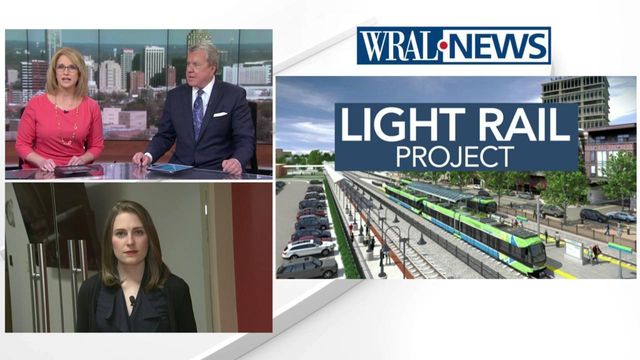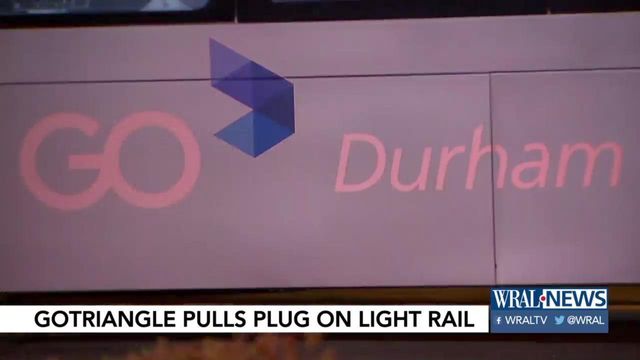GoTriangle board votes to end its pursuit of Durham-Orange light rail
GoTriangle voted to pull the plug on the Durham-Orange light rail project Wednesday, stepping back from a linchpin of the region's transit plans with more than $130 million spent on planning.
A pile-up of problems – cost overruns, languid private fundraising, lackluster legislative support and no deals in sight with key partners in Duke University and the N.C. Railroad – made the project untenable. GoTriangle, the area's regional transit authority, was spending $7 million a month on design work and consultants to keep things moving forward months after the project's end seemed nigh.
Wednesday's vote was unanimous. Two board members, including Chairwoman Ellen Reckhow, shed a few tears once it was done.
The project had been under discussion for decades, and Durham and Orange county taxpayers voted in a sales tax to gin up funding starting in 2011. It's budget was essentially half a billion dollars short when the board voted to pull the plug.
"I don't really think that I can overstate my disappointment," Durham Mayor and GoTriangle board member Steve Schewel said just before the vote. "This is a tremendous setback for our region."
The vote wasn't final, though it felt that way. It will be up the Durham and Orange county boards of commissioners to make final decisions on the board's recommendation.
GoTriangle CEO Jeff Mann said staff would wind down the project so it could restart if possible, and look for ways to re-use planning already done along the corridor. But once the counties vote to end, the project will be out of the running for $1.2 billion it was depending on from the federal government.
Durham County Commission Chairwoman Wendy Jacobs said the region won't get another shot at federal money like that.
"It is a huge loss," she said.
There was blame to go around.
Duke University bore the brunt of a public backlash the last few months, because it refused to give up land needed for the project.
The university complained the electric train would produce electromagnetic interference and vibrations that might bother sensitive hospital equipment or surgical procedures. Other hospitals around the country have electric train lines running nearby, though, and the plan also called for a stop near UNC Hospital.
But several board members, including Reckhow, wanted people to know Wednesday that the situation was complicated beyond Duke's unwillingness. Mann said he had a meeting last week with Federal Transit Administration officials who saw "very low probability" the project would come together by a deadline put in place by the N.C. General Assembly.
Previous light rail projects in Charlotte got 25 percent of their funding from the state. This one was slated for 7.7 percent thanks to a $190 million cap legislators approved last year. They also put in a Nov. 30 deadline to secure all other funding, or the state money would go away.
Orange County Commissioner Mark Marcoplos, a Democrat on the GoTriangle board, said the legislature seemed "almost vindictive."
"Probably the biggest blow was the legislature hobbling us with ankle weights then challenging us to run the race," he said.
But the project had lingered, and the costs had risen too high for some at the statehouse. The latest figures from the federal government put funding at $267 million short, including an $87 million shortfall in the private money supporters hoped to raise.
The project also needed access to another $271 million – 10 percent of total construction costs – as a backstop against future overruns, or the federal government wouldn't kick in its money. Mann said the project was due to run out of cash for consultants in about August and needed another $50 million to $70 million to finish design and other work ahead of construction.
Speaker of the House Tim Moore said Wednesday that perhaps some of the project's funding could be used to widen Interstate 40 in the counties.
"The complaint that we were hearing a lot was the cost that was going to be incurred for this project – that for the cost of just a few miles of rail, you could really make substantive improvements to the interstate," said Moore, R-Cleveland. "A lot of members believed the investment really needed to be made in improving those roads before looking at the light rail."
Reckhow said the planners believed for years they had a solid partner in Duke University, and that she didn't hear about EMI and vibration issues until October. She said the university took months to provide key data about equipment that could have been affected and how close it would be to the tracks – important information, given how quickly interference and vibrations die away.
Asked to respond to those specific issues Wednesday, Duke Vice Vice President for Public Affairs and Government Relations Michael Schoenfeld declined, pointing instead to GoTriangle's own descriptions of the "ultimately insurmountable financial and logistical challenges that had to be solved in addition to the route adjacent to the Duke campus."
"The need for a comprehensive, sustainable and dynamic regional transit solution is more urgent than ever," Schoenfeld said in an email. "Duke will be an enthusiastic participant in developing a plan that serves the greatest number of our citizens, and makes the best and most effective use of all modes of transportation and new technologies."
Schewel said Duke University dealt "the final blow" to a struggling project. He said legislative hostility underlay its problems.
Reckhow said the partial federal government shutdown earlier this year also hurt the project, delaying key reports from the Federal Transit Administration. She and other board members also pointed to the N.C. Railroad, a private entity owned by the state that controls tracks along part of the planned line, and which declined to sign a final agreement for the project.
Mann said Wednesday that the railroad wanted $30 million to use land along its corridor. GoTriangle had valued it at $4 million.
Staff indicated Wednesday that there would be some ongoing costs from the coming wind-down, but it wasn't clear how much. The board dispensed with a $14 million contract extension for HDR Engineering, though, removing it from Wednesday's agenda after the vote to discontinue.
HDR has been handling design work and is the project's largest contractor.
Mann said staff would come back with an estimate to mothball the rail project and repurpose what work it can.
"We're not just going to cut the lights off and walk out," he said.
Previously ...
Update: 3:00 p.m.:
After years of planning, years of negotiations and an investment that already totals more than $130 million, the GoTriangle Board of Trustees has voted to end its efforts on the Durham-Orange County light-rail project.
Trustees used the word "mothballing" to describe the action, but also acknowledged that it would be nearly impossible to revive the project.
The vote to end the project was unanimous.
GoTriangle was never able to secure an agreement with Duke University over the proposed route of the light-rail system. A GoTriangle map has the trains running along Erwin Road, directly in front of Duke University Medical Center. School and hospital officials expressed concern over potential vibrations from the system both during and after construction, and over the possibility of the system generating electromagnetic interference that could affect delicate medical and research instruments.
The project also remained hundreds of millions of dollars short of the needed commitments with deadlines looming for both state and federal funding.
Update 2:05 p.m.:
The GoTriangle board has returned from closed session to continue its discussion of the future of the Durham-Orange Light-Rail Transit project.
Update 1:10 p.m.:
The GoTriangle Board of Trustees has gone into closed session to discuss the Durham-Orange Light-Rail Transit project.
Prior to going into closed session, trustee Wendy Jacobs was quizzing project director John Tallmadge on possible ways to trim $190 million from the cost of the $2.7 billion project.
Tallmadge suggested reducing the number of stops and buying fewer or smaller cars as options. He also mentioned possibly trimming the length of the proposed line, which he said could only be done at the North Carolina Central University end of the project.
Ending the route at Alston Avenue, he said, would save $60 million.
But ending the line there, Jacobs responded, "would be not good."
Previously:
The GoTriangle Board of Trustees is meeting to discuss the future of the Durham-Orange Light-Rail project.
The project remains millions of dollars short of its needed budget commitments and one of its key partners, Duke University, has withdrawn its support.











